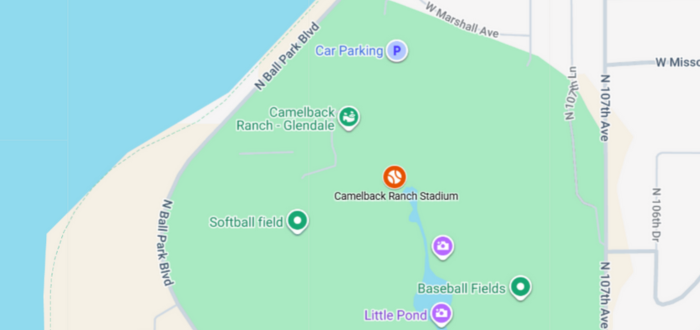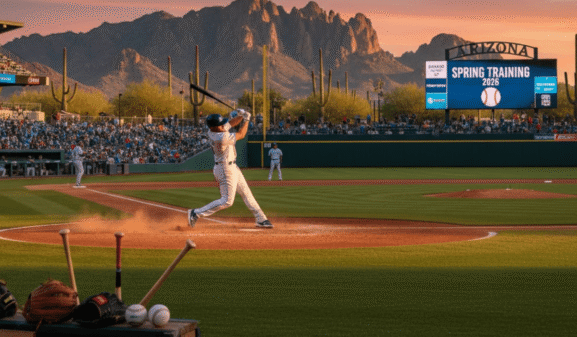LA Dodgers Spring Training 2026 Location & Map
Every February, baseball fans start dreaming of sunshine, fresh-cut grass, and the crack of the bat—and if you bleed Dodger blue, you’re probably wondering exactly where to find your team this spring. The LA Dodgers’ spring training location has been a Phoenix-area fixture for nearly two decades, and 2026 will be no different. Whether you’re a first-time visitor or a spring training veteran, this guide delivers everything you need to know about where the Dodgers will play, practice, and prepare for the season ahead.
Spring training isn’t just about baseball—it’s a pilgrimage. It’s autograph sessions with rising prospects, sun-soaked afternoons on the berm, and the relaxed atmosphere that makes Major League Baseball feel accessible again. For 2026, the Dodgers return to their desert home, and this article walks you through the location details, historical context, fan experience, and practical tips that turn a good trip into an unforgettable one.
Quick Takeaways
- Camelback Ranch–Glendale remains the official Dodgers spring training location in 2026, continuing an Arizona tradition since 2009
- The complex sits at 10710 W. Camelback Rd in Glendale, roughly 20 minutes from downtown Phoenix, with ample parking and transit options
- Expect 14–15 Cactus League home games at the 10,000-seat stadium, plus additional practice sessions open to fans
- The Dodgers left Florida’s iconic Dodgertown in 2008, trading Vero Beach nostalgia for state-of-the-art Arizona facilities
- Early arrival unlocks batting practice access and autograph opportunities, especially on weekday mornings when crowds thin
- Tickets typically release after MLB’s official schedule announcement, so bookmark the team page and set calendar reminders now
Where Is the Dodgers’ Spring Training 2026 Located
Camelback Ranch–Glendale, a sprawling, purpose-built baseball campus in the west Phoenix suburbs. This isn’t a makeshift facility or a repurposed minor-league park—it’s a 141-acre complex designed from the ground up to serve the spring training needs of both the Los Angeles Dodgers and the Chicago White Sox, who share the site under a unique dual-tenant arrangement.
The physical address—10710 W. Camelback Rd, Glendale, AZ 85037—puts you squarely in Cactus League territory, where a dozen MLB teams train within a one-hour drive. Camelback Ranch anchors the western edge of that circuit, making it an ideal base camp if you’re planning a multi-stadium spring training tour.
What Makes Camelback Ranch Special
Opened in March 2009, Camelback Ranch represents a modern approach to spring training infrastructure. The main stadium seats roughly 10,000 fans in fixed seating, with additional berm and lawn areas that push capacity higher on sellout days. But the real magic happens beyond the main field: 13 full-sized practice diamonds fan out across the property, connected by walking paths that let fans drift from one workout to the next. Lakes and landscaping separate the Dodgers’ half of the complex from the White Sox side, creating distinct team atmospheres while maximizing shared resources.
For fans accustomed to the intimate, throwback feel of older spring sites, Camelback strikes a balance—large enough to feel like a real ballpark experience, yet open enough that you can watch Clayton Kershaw’s bullpen session from ten feet away on a quiet Tuesday morning. That accessibility defines the spring training Dodgers location experience and keeps fans coming back year after year.
Read more: LA Dodgers Spring Training 2026 Tickets are Live: Price & How to Buy
The 2026 schedule will mirror recent seasons: home games at Camelback Ranch interspersed with road trips to nearby Cactus League parks in Scottsdale, Mesa, Tempe, and Surprise. Check the Dodgers’ official spring training page once MLB releases the full calendar—typically in late fall—and plan your visit around marquee matchups or prospect showcases that align with your interests.
Getting to Camelback Ranch & Location Map

Camelback Ranch sits roughly 20 minutes west of downtown Phoenix and 30 minutes from Phoenix Sky Harbor International Airport, depending on traffic. Most visitors rent a car—Arizona’s sprawl makes driving the most flexible option, especially if you’re hopping between multiple Cactus League sites. GPS coordinates (33.5122° N, -112.2950° W) will route you directly to the main entrance off Camelback Road.
Parking at the complex is plentiful on most days, with dedicated lots surrounding the stadium. Expect to pay a modest fee (typically $10–$15) on game days, with proceeds often benefiting local charities. On high-demand days—opening weekend, rivalry games against the Giants or Angels, or Sunday afternoon sellouts—arrive early or consider ride-share options to avoid lot congestion.
Public transit exists but isn’t ideal: Phoenix’s Valley Metro bus system serves the general area, but routes don’t drop you at the stadium gates. If you’re staying in nearby Glendale or central Phoenix, ride-share apps like Uber and Lyft offer the easiest door-to-door solution.
Inside the Complex
Once you’re through the gates, Camelback Ranch feels more like a baseball theme park than a single stadium. The Dodgers’ spring training field occupies the western half of the property, with the main stadium anchoring game-day activity. But walk the perimeter paths and you’ll find a half-dozen practice diamonds where minor leaguers and rehabbing veterans run drills, hit BP, and play intrasquad games—all visible from fan-accessible viewing areas.
Concession stands dot the concourse, offering typical ballpark fare plus Arizona touches like carne asada nachos and craft beers from local breweries. Merchandise tents sell spring-exclusive gear that you won’t find at Dodger Stadium, making them prime shopping stops for collectors.
The berm seating—grassy hills beyond the outfield—lets families spread blankets and play catch between innings, creating a festival vibe that’s rare in regular-season parks. Kids love it, and adults appreciate the relaxed rules around movement and noise. This is spring training: baseball without the pressure, where a strikeout doesn’t spark boos and a home run prompts high-fives with strangers.
Read more: LA Dodgers Spring Training 2026 Schedule
Dodgers Spring Training Location History
Understanding where the Dodgers train today requires a look back at one of baseball’s most beloved traditions. From 1948 through 2008, the Los Angeles Dodgers (and Brooklyn Dodgers before them) called Vero Beach, Florida, home each spring. “Dodgertown” wasn’t just a training facility—it was a self-contained baseball village built around Holman Stadium, where legends from Jackie Robinson to Sandy Koufax to Fernando Valenzuela honed their skills against a backdrop of Spanish moss and Atlantic breezes.
Dodgertown embodied old-school spring training: players lived in on-site barracks, fans picnicked on the outfield berms, and the entire community of Vero Beach revolved around the Dodgers’ arrival each February. For six decades, that Florida location became synonymous with Dodger spring baseball, creating memories that still resonate with longtime fans.
The Shift to Arizona
In 2009, everything changed. The Dodgers’ spring training location history took a dramatic turn when ownership—facing aging infrastructure in Vero Beach and recognizing broader MLB trends—announced the move to Camelback Ranch. The decision aligned the Dodgers with the Cactus League’s geographic and logistical advantages: shorter travel for West Coast teams, more predictable weather, and proximity to a growing Arizona fan base.
The move wasn’t without controversy. Purists mourned the loss of Dodgertown’s intimacy and tradition. But the organization prioritized player development and fan amenities, investing in a facility that could support modern training methods—video analysis rooms, expanded weight training areas, upgraded medical facilities—that Vero Beach simply couldn’t match without massive renovation.
By 2009, the Dodgers’ spring training location in Florida had closed, and the Arizona era began. Fifteen years later, Camelback Ranch feels as much a part of Dodger spring tradition as Dodgertown once did, proving that while locations change, the ritual and passion of spring training endure.
Where Do the Dodgers Play for Spring Training
When people ask “where do the Dodgers play for spring training,” they’re often curious about both the competitive schedule and the broader fan experience. Let’s break down both.
The 2026 Cactus League Schedule
The Dodgers will play approximately 14–15 home games at Camelback Ranch during the 2026 spring season, which typically runs from late February through late March. These games pit the Dodgers against fellow Cactus League teams—expect matchups with division rivals like the Giants, Padres, and Diamondbacks, plus interleague exhibitions against American League clubs training nearby.
Home games start mid-morning or early afternoon to accommodate Arizona’s spring heat (even in February, temps can hit 80°F by 2 p.m.). First pitch times vary, so check the official schedule once MLB releases it—usually in the fall preceding spring training.
Beyond the Cactus League games, the Dodgers host intrasquad scrimmages and minor-league games that don’t appear on the main ticket calendar. These lower-key contests offer the best chance to see top prospects and rehabbing stars in game action without the crowds or ticket costs of a marquee matchup.
Ticket Strategy
Tickets for Dodgers spring training games typically go on sale in late fall or early winter, with the team offering both single-game tickets and multi-game packages. Prices are remarkably affordable compared to regular season—expect $15–$40 for most seats, with premium areas near the dugouts climbing toward $60.
Pro tip: Weekday games draw smaller crowds than weekend or Opening Day exhibitions. If you want elbow room, autograph access, and easier parking, target a Tuesday or Wednesday afternoon game against a non-rival opponent. You’ll see the same players and experience the same facility, but with half the hassle.
Beyond the Games
Where do the Dodgers do spring training drills and workouts? Right there on the practice fields adjacent to the stadium. Morning workouts—usually starting around 09 a.m.—are open to the public on most days. Fans can watch pitchers throw bullpen sessions, infielders take ground balls, and hitters work in the cages. Autograph seekers position themselves along the ropes separating fans from players, hoping for a signature from a rookie trying to make the Opening Day roster or a veteran wrapping up a Hall of Fame career.
This access defines the spring training experience. Where else can you watch a Cy Young winner fine-tune his changeup from close enough to hear the catcher’s chatter? That’s the magic of Camelback Ranch and the reason thousands of fans make the Arizona Dodgers spring training pilgrimage every year.
Practical Fan Tips
- Dress for the sun: Arizona’s February/March weather is gorgeous but intense. Bring sunscreen, a hat, and sunglasses—there’s limited shade in the bleachers.
- Hydrate: Even 75°F feels hot under direct sun. The complex has water fountains, but bring a refillable bottle.
- Arrive early: Gates open 90 minutes before the first pitch. Early birds get prime berm spots, better parking, and more autograph opportunities.
- Explore the fields: Don’t just sit in the stadium. Walk the complex, watch the minor leaguers, and soak up the full spring training atmosphere.
- Check the Dodgers’ social media: The team posts daily workout times and special events (like player meet-and-greets) that aren’t on the main schedule.
Planning Your 2026 Visit
Now that you know where the LA Dodgers have spring training, it’s time to turn knowledge into action. Here’s a step-by-step plan to maximize your Camelback Ranch experience.
Step 1: Monitor the Schedule Release
Bookmark the Dodgers’ official spring training page on MLB.com and follow the team’s social media accounts. Schedule announcements typically drop in October or November, giving you months to plan travel. As soon as the calendar is live, identify target games—rivalry matchups, weekend dates that fit your schedule, or quieter weekday games if you prefer smaller crowds.
Step 2: Secure Tickets
Set a reminder for the ticket on-sale date (announced alongside the schedule). Single-game tickets sell out slowly for most games, but Opening Day and high-profile weekend matchups move fast. If you’re planning to attend multiple games, consider a mini-plan or flex pack—these bundles offer slight discounts and guarantee seat selection before single-game buyers.
For a truly local experience, some fans skip the main stadium entirely and spend their day hopping between practice fields. Admission to the complex grounds is often free or low-cost on non-game days, letting you watch workouts up close without a ticket purchase.
Step 3: Book Accommodations
Glendale and nearby Peoria offer hotel clusters within 10–15 minutes of Camelback Ranch. Downtown Phoenix provides more dining and nightlife options but adds drive time. Scottsdale—25 minutes east—combines resort amenities with proximity to other Cactus League parks, making it ideal for multi-stadium tours.
Spring training season overlaps with Phoenix’s peak tourism months (February–April), so book early for the best rates. Airbnb and VRBO rentals around Glendale can offer better value for groups or families planning multi-day stays.
Step 4: Build Your Itinerary
Don’t just watch games—experience spring training culture. Visit other Cactus League parks (Scottsdale Stadium for the Giants, Sloan Park for the Cubs, and Tempe Diablo Stadium for the Angels are all within 30 minutes. Explore Phoenix-area hiking trails like Camelback Mountain or Papago Park. Sample the region’s Mexican food and craft beer scene. Spring training works best as a long weekend experience, not just a day trip.
Conclusion
So, where is the Dodgers’ spring training located? Camelback Ranch in Glendale, Arizona—a modern, fan-friendly complex that has redefined the Dodgers’ spring identity since 2009. The Los Angeles Dodgers spring training location offers everything today’s fans expect: accessibility to players, quality facilities, beautiful weather, and a festival atmosphere that makes baseball feel like a celebration rather than a competition.
The location of the Dodgers’ spring training may have changed from Florida’s Dodgertown to Arizona’s desert landscape, but the spirit remains the same. Spring training is about renewal—for players shaking off winter rust, for fans reconnecting with the game they love, and for communities welcoming baseball back each February. Camelback Ranch delivers on all those fronts.
Whether you’re asking “where are the Dodgers spring training” for the first time or you’re a returning visitor planning your tenth trip, the 2026 season promises the same blend of accessibility, sunshine, and pure baseball joy that has made Camelback Ranch a pilgrimage site for Dodger fans worldwide. The stadium location, the practice field layout, and the fan-first amenities all contribute to an experience that’s worth the trip—whether you’re flying across the country or driving from nearby Scottsdale.
Action Steps
- Bookmark the official Dodgers spring training page at MLB.com and enable alerts for schedule and ticket announcements
- Set a calendar reminder for November 2025 to check for the 2026 spring schedule release and ticket on-sale dates
- Choose your target games now—weekday for intimacy, weekend for energy, or opening week for roster intrigue
- Research accommodation options in Glendale or Phoenix and monitor pricing as spring approaches
- Pack smart: sunscreen, hat, sunglasses, camera, refillable water bottle, and a Sharpie for autographs
Spring training is baseball at its purest—no pennant pressure, no playoff stakes, just the game and the sunshine and the promise of six months ahead. Camelback Ranch in 2026 will deliver all of that, and now you know exactly where to find it.
FAQ
Q1: Where are the Dodgers’ spring training games played in 2026?
The Dodgers play their 2026 spring training home games at Camelback Ranch–Glendale, located at 10710 W. Camelback Rd in Glendale, Arizona. The complex has hosted Dodgers spring training since 2009 and will continue that role through 2026, with approximately 14–15 Cactus League home games scheduled for the season.
Q2: What is the address of the Dodgers’ spring training stadium?
The official address for Camelback Ranch is 10710 W. Camelback Rd, Glendale, AZ 85037. GPS coordinates (33.5122° N, -112.2950° W) will route you directly to the main entrance. The facility is roughly 20 minutes west of downtown Phoenix and 30 minutes from Phoenix Sky Harbor International Airport.
Q3: Did the Dodgers always train in Arizona?
No—the Dodgers trained at Dodgertown in Vero Beach, Florida from 1948 through 2008, creating one of baseball’s most iconic spring training traditions. The organization moved to Camelback Ranch when the new Arizona complex opened in 2009, shifting from the Grapefruit League to the Cactus League and marking the end of a 60-year Florida era.
Q4: How many home spring games will the Dodgers play at Camelback Ranch in 2026?
The 2026 spring schedule typically includes 14–15 home games at Camelback Ranch, though the final count depends on MLB’s official Cactus League calendar release. Home games are interspersed with road contests at other Arizona spring training sites, giving fans multiple opportunities to see the Dodgers throughout February and March.
Q5: Can I watch Dodgers practice sessions at Camelback Ranch?
Yes—morning workouts on the practice fields are generally open to the public, usually starting around 09 a.m. Fans can watch batting practice, fielding drills, and bullpen sessions from designated viewing areas. Autograph opportunities are best during these practice sessions, especially on weekdays when crowds are lighter than game days.


